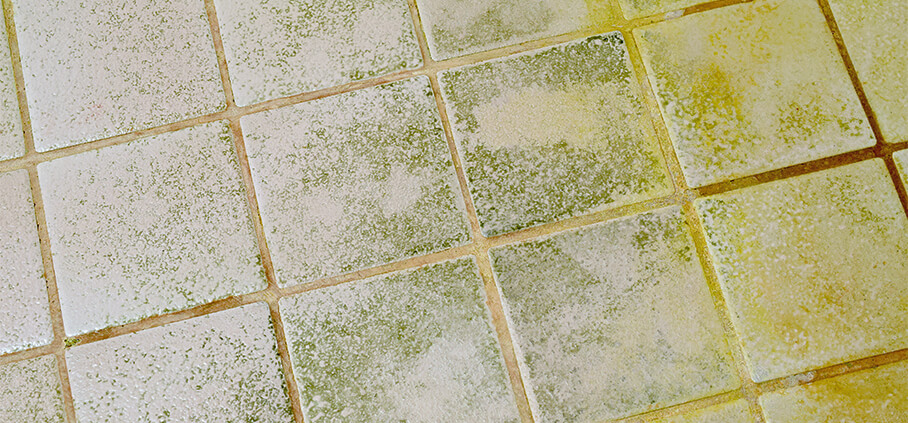Last update: 1 year ago

Removing paint from tiles and grout on your own can be a difficult task, as you can do more harm than good if you don’t have experience in the matter. Of course, not anyone can have expertise in after builders cleaning, right? The process is tricky and time-consuming, but with the right tools and a few helpful tips, you’ll deal with the stubborn marks smoothly!
If you’re dealing with wet paint, you can simply wipe it away with a cloth. You’ll have to act fast and get rid of it while it’s still wet. If the paint has dried, try one of the methods listed below!
Scrape the paint away
Using a scraper is one of the most inexpensive yet effective ways to remove dry paint from your tiles. To do the job, you’ll need the following items: a plastic scraper or a utility knife, a dust mask, and a damp cloth.
Here’s how to remove paint from tiles and grout by scraping:
- Pick the right scraping tool.
We don’t recommend using a utility knife on glazed tiles, as it will surely damage them. Your best bet would be a plastic scraper. - Start scraping.
Softly scrape the paint off a small area of the tile, holding the scraper at an angle and pushing gently. If you notice the glaze is being scratched, stop immediately and try an alternate method to deal with the paint. If there are no cracks and flakes, continue the process until you eliminate all problem areas. - Clean up.
After you finish scraping the paint from the tiles and grout, clean them up with a damp cloth.
Using heat & scrape to remove paint
A heat gun is a great tool to help loosen up stubborn or old paint (over 30 years old), especially when it comes to slightly porous tiles, such as ceramic. Here’s what you’ll need: a heat gun, plastic scraper or utility knife, rubber gloves, protection mask, and a soft cloth.
- Wipe away the dust.
Begin by wiping out dirt or dust from your tiles. - Heat up the paint.
Turn on the heat gun and loosen the paint. Work in small areas, moving the heat gun back and forth slowly until the paint softens up. This procedure requires a little extra care, as you can easily char your tiles if you’re not careful. To avoid this, don’t leave the heat gun in the same spot for too long. - Scrape.
Take the scraper or utility knife, hold it at a 45-degree angle and carefully remove the paint from the tile. It is best to start from the corner and work your way to the middle. This will prevent scorch marks and flakes. Take extra care when working near the corners of your tiles, as there is a chance to chip them. - Clean up during the process.
Every few minutes, clean the surface of the tile with a microfiber cloth to make sure all of the excess paint is removed.
Using paint remover
Using paint remover is your best bet when it comes to very stubborn paint. If your tiles are damaged, opting for this method will also help you avoid making it worse. You’ll need the following items: a microfibre cloth or a sponge, a soft brush, paint remover, dish soap, safety goggles, and rubber gloves.
- Put on your safety gear.
Don’t forget to put your goggles and gloves on before you start. - Clean the tiles.
Start by cleaning the tiles – you can use a solution of white vinegar and water to do this. After that, wipe any residue off the wall with a clean, damp cloth. - Test the product and remove the paint.
Following the instructions on the label, apply some paint remover on an inconspicuous area of the tile with a clean cloth. Wait for the recommended time, then scrape the paint off like you normally would. If you don’t see any damage to the tile, you can safely remove all the paint with this product. - Clean up.
Once all the paint is gone, clean up the tiles. Use a solution of dish soap and warm water, then wipe the tiles dry with a clean cloth.
When purchasing commercial paint remover, make sure you get the right kind for your tiles. Let the staff know what tiles you’re working with, so they can point you in the right direction. If you’re not sure, a citrus-based paint remover is a good option.
No matter what kind of product you are using, make sure the room is well-ventilated. Open the windows and, if possible, turn on a fan or an air conditioner!
Removing paint from grout
Removing paint from unsealed, porous grout can be a tough nut to crack but worry not – we’ve got you covered. Here’s what you can do:
- Wipe it up – If the paint on the porous grout is moderately fresh, simply wipe it up with a soapy rag or paint thinner. This method can also be implemented for water-based paint. If the paint is oil-based, then you must act quickly. The porous surface of the grout will immediately soak up the paint, leading to permanent damage. If that’s the case, the only solution, unfortunately, is for you to scrape and re-grout the area.
- Apply epoxy – If you prefer to not have to re-grout the area, then you should consider applying a coloured epoxy to the grout. This will restore the colour of your grout and it will help seal the surface. Gently apply the colourant by using a toothbrush. Experienced cleaners guarantee that the end result will be a fresh-looking grout that is free of paint stains.
- Apply rubbing alcohol – You can also use rubbing alcohol to blot out the paint. To do this, dip your cloth into the alcohol and dab the stained grout until it removes the paint completely.
Can you remove paint with paint thinner, nail polish, or vinegar?
If you want to make removing paint from tiles easier but don’t want to use paint remover, you might be looking for some alternatives, such as paint thinner, nail polish, or – if you want a natural solution – vinegar. Let us answer your question.
Paint thinner
This is a mineral solvent used to thin oil-based paint, making it easier to remove. However, this only works while the paint is still wet. For dried up oil paint, you’ll have to resort to a different method.
Paint thinner is a harsh chemical that, in most cases, can cause skin irritation or a general allergic reaction. So, it is important to wear protective clothing when working with it. Always work in a well-ventilated area.
Test small areas on your tiles and grout before you clean paint with the solvent. Use a rag or a cotton swab to apply the paint thinner. Scrub carefully, then blot the area clean when done. To remove the chemical, use a solution of 3 cups of water combined with 2 teaspoons of dish soap.
Vinegar
This is a cheap and easy way to remove dried paint from your tiles. It’s also a natural, eco-friendly solution – a great alternative to chemicals that will still remove more stubborn stains with no risk to your health.
To remove paint splatter off your tiles and grout, heat a small amount of white distilled vinegar mixed with essential oils. Dip a microfibre cloth in the mixture and dab it on the dried up paint. Let the solution sit for 10-15 minutes – more than enough to soften the paint. Next, remove the loosened paint with a scraper. Clean the surface with a damp rag and enjoy your paint-free tiles.
Nail polish remover
This solvent is an easy and inexpensive solution when dealing with oil-based paints, as acetone is effective for both dried and fresh paint.
Start by scraping the paint with a plastic scraper or a utility knife. Pour a small amount of nail polish remover onto a clean microfibre cloth afterwards and dab it on the tile. Leave it for a few minutes so the paint can soften. Scrub the tiles with the acetone-soaked cloth to remove the excess paint. Finally, rinse the rag with soapy water to eliminate any acetone deposit.
Takeaways
- You can clean the paint splatter from your tiles and grout easily by using either commercial or domestic products.
- Be careful with what you use to clean your tiles, as you can damage them if you use improper solutions.
- Most dried up paint can be removed by scraping. If you need a little extra power, use a heat gun to loosen the paint beforehand.
- For very stubborn paint, use a paint remover. Just make sure it won’t damage the type of tile you have.
- Oil-based paint can be removed with the help of paint thinner or nail polish remover.
- Vinegar combined with essential oils is an excellent way to remove paint stains from your tiles and grout.
- Always use protective clothing (gloves, masks) when scraping or dissolving paint!
- Opt for professional help with cleaning, if necessary.
Do you need a helping hand?
Hire a professional cleaning team!









